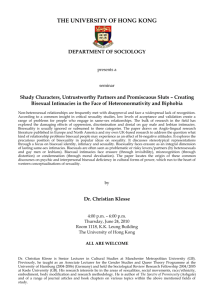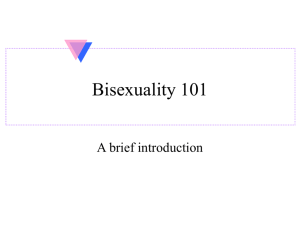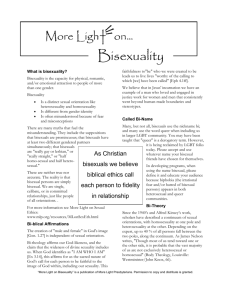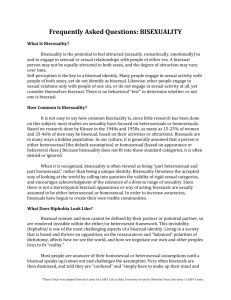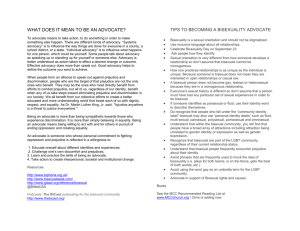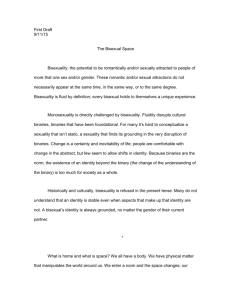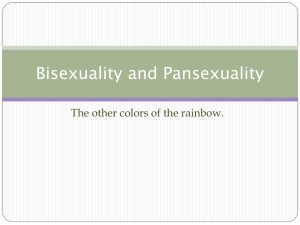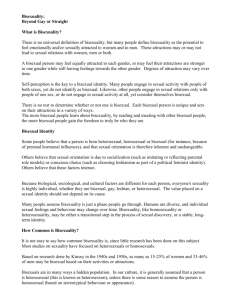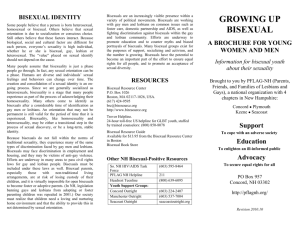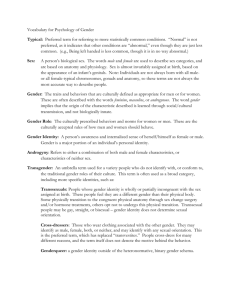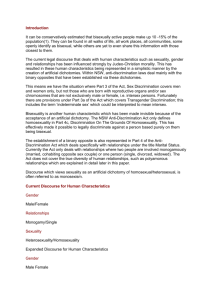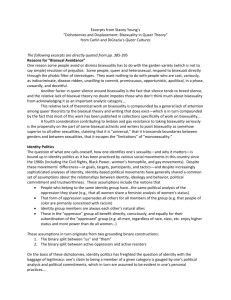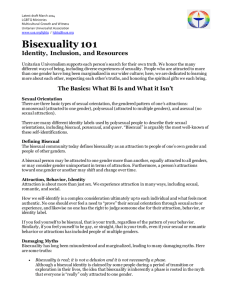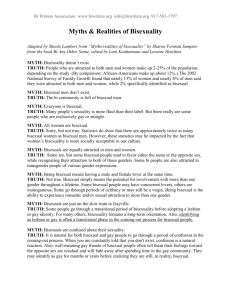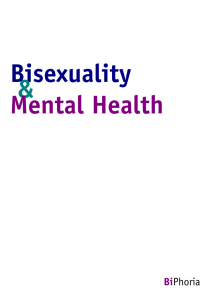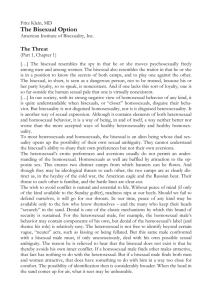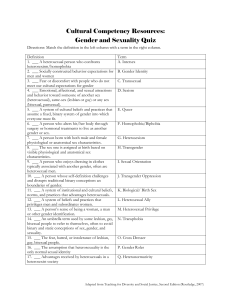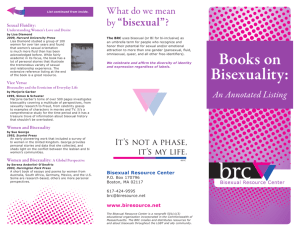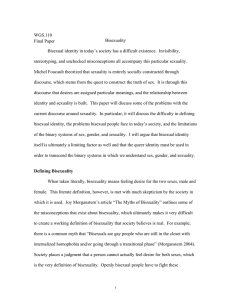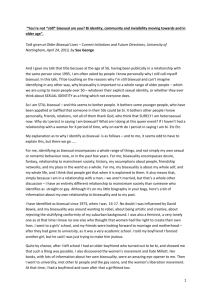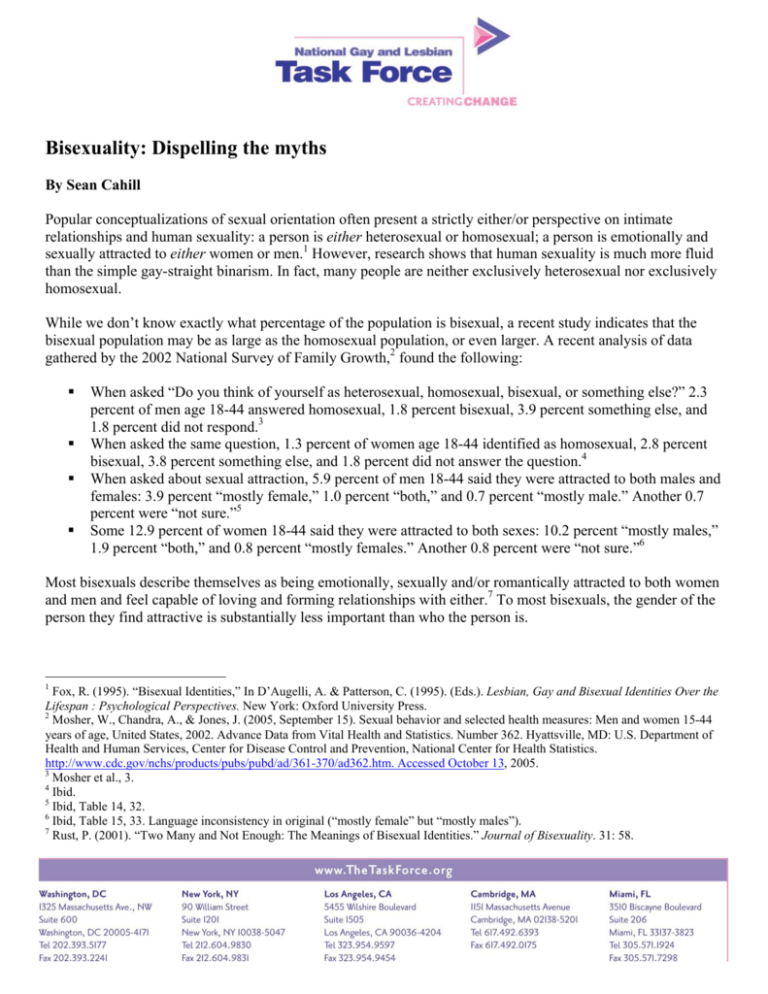
Bisexuality: Dispelling the myths
By Sean Cahill
Popular conceptualizations of sexual orientation often present a strictly either/or perspective on intimate
relationships and human sexuality: a person is either heterosexual or homosexual; a person is emotionally and
sexually attracted to either women or men.1 However, research shows that human sexuality is much more fluid
than the simple gay-straight binarism. In fact, many people are neither exclusively heterosexual nor exclusively
homosexual.
While we don’t know exactly what percentage of the population is bisexual, a recent study indicates that the
bisexual population may be as large as the homosexual population, or even larger. A recent analysis of data
gathered by the 2002 National Survey of Family Growth,2 found the following:
When asked “Do you think of yourself as heterosexual, homosexual, bisexual, or something else?” 2.3
percent of men age 18-44 answered homosexual, 1.8 percent bisexual, 3.9 percent something else, and
1.8 percent did not respond.3
When asked the same question, 1.3 percent of women age 18-44 identified as homosexual, 2.8 percent
bisexual, 3.8 percent something else, and 1.8 percent did not answer the question.4
When asked about sexual attraction, 5.9 percent of men 18-44 said they were attracted to both males and
females: 3.9 percent “mostly female,” 1.0 percent “both,” and 0.7 percent “mostly male.” Another 0.7
percent were “not sure.”5
Some 12.9 percent of women 18-44 said they were attracted to both sexes: 10.2 percent “mostly males,”
1.9 percent “both,” and 0.8 percent “mostly females.” Another 0.8 percent were “not sure.”6
Most bisexuals describe themselves as being emotionally, sexually and/or romantically attracted to both women
and men and feel capable of loving and forming relationships with either.7 To most bisexuals, the gender of the
person they find attractive is substantially less important than who the person is.
1
Fox, R. (1995). “Bisexual Identities,” In D’Augelli, A. & Patterson, C. (1995). (Eds.). Lesbian, Gay and Bisexual Identities Over the
Lifespan : Psychological Perspectives. New York: Oxford University Press.
2
Mosher, W., Chandra, A., & Jones, J. (2005, September 15). Sexual behavior and selected health measures: Men and women 15-44
years of age, United States, 2002. Advance Data from Vital Health and Statistics. Number 362. Hyattsville, MD: U.S. Department of
Health and Human Services, Center for Disease Control and Prevention, National Center for Health Statistics.
http://www.cdc.gov/nchs/products/pubs/pubd/ad/361-370/ad362.htm. Accessed October 13, 2005.
3
Mosher et al., 3.
4
Ibid.
5
Ibid, Table 14, 32.
6
Ibid, Table 15, 33. Language inconsistency in original (“mostly female” but “mostly males”).
7
Rust, P. (2001). “Two Many and Not Enough: The Meanings of Bisexual Identities.” Journal of Bisexuality. 31: 58.
Contrary to common misperceptions, bisexuality is not the equivalent of sexual promiscuity.8 Most bisexuals
describe themselves as monogamous in their committed relationships.9 Bisexual identity speaks more to the
existence of attraction to people of either gender, rather than a statement of past or current sexual activity.
Also contrary to common misperceptions, bisexuality is not a transitional phase between heterosexuality and
homosexuality. No single pattern exists among bisexuals. Some have experienced both same-sex and oppositesex relationships though others have only experienced one or the other.10 Some feel they fit into neither the
heterosexual nor homosexual worlds, while others feel identified more predominantly with one or the other.11
Due to the lack of understanding, acceptance, or even acknowledgment of bisexual identity, the family
relationship issues facing bisexual people seldom emerge when contemplating policy and legal changes. Some
bisexual people are legally married to opposite-sex partners.12 As a result, they are able to access the privileges
afforded to married couples. However, many bisexual people are not married either by choice or because they
are in same-sex relationships and live in one of the 49 states in which same-sex couples cannot marry. If they
are committed to an opposite-sex partner they may nevertheless find the discriminatory aspects of marriage to
run counter to their belief system. Finally, bisexual people often face similar discrimination and obstacles as
gays and lesbians with regard to custody, visitation and adoption of children.
Sean Cahill directs the National Gay and Lesbian Task Force Policy Institute.
8
Ibid, p. 57.
Ibid, p. 65.
10
Fox, (1995), p. 73
11
Ibid.
12
Rust, (2001); Fox, (1995).
9


